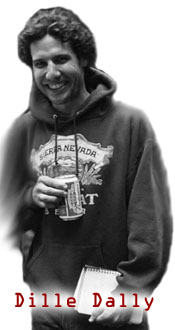 Breaking a collarbone is a common cycling injury. I’ve broken my left collarbone three times in three decades. The first time I broke it I was nine. I caught “mad air” off a jump while skiing at Squaw Valley and landed awkwardly. The tumble foreshadowed a general unawareness of pain (and many future hospital visits). When the examining physician asked me to salute him with my busted arm, I eagerly raised my hand over my head.
Breaking a collarbone is a common cycling injury. I’ve broken my left collarbone three times in three decades. The first time I broke it I was nine. I caught “mad air” off a jump while skiing at Squaw Valley and landed awkwardly. The tumble foreshadowed a general unawareness of pain (and many future hospital visits). When the examining physician asked me to salute him with my busted arm, I eagerly raised my hand over my head.
“He’s not supposed to be able to do that,” the doctor whispered to my mom.
The second break occurred when I was 19. I hit a cone on the rollout of the LiveStrong ride, an accident the former heads of the Lance Armstrong Foundation still refer to as “the incident.” The fall came at the culmination of a series of crashes incurred during my first year of racing, including an encounter with a barbed wire fence that required stitches in my left pinkie finger and a tetanus shot.
Angry and frustrated after the second fracture, I announced my intent to return to running, a sport less prone to high-speed collisions. Then, a complimentary get-well note from a senior member of the cycling team lifted my spirits. “Ian, hope you heal up and return to racing soon,” it said. “You’ve got a lot of raw talent—key word, ‘raw.’”
As I write this, my left arm is again in a sling. I broke my collarbone in a race last May, at the age of 29. It didn’t heal quite right and recently required surgery involving bone grafting from a cadaver. “You can only break a bone so many times,” the doctor said after I reluctantly agreed to the operation. The procedure took longer than expected. The surgeon had to bend the plate to match my gnarled clavicle and insert 10 screws.
Injuries like my multiple collarbone fractures are an irony in cycling: We often hurt ourselves participating in a sport that otherwise makes us ridiculously healthy. The nurses who checked me in at the hospital marveled at my spot on blood pressure and low resting heart rate. “We always know when we’ve got an athlete,” they said.
Cyclists frequently hear refrains like these from health professionals. But for most of us, the health benefits are a result of riding, not the intent. Biking is a means for exploration, an excuse to spend an entire afternoon outdoors. It’s an opportunity to challenge ourselves in competition, and see how we stack up against others. The majority of us don’t ride to burn calories and reduce stress. Those are the awesome side effects.
As I waited for the anesthesiologist to arrive, the nurses checked in the patient next to me. He was an older, overweight man—and obviously not an athlete. He joked about pouring bourbon into his morning coffee and made mildly inappropriate comments to the attendants. Type 2 Diabetes had caused him to lose much of the circulation to his extremities, including the blood vessels in his feet. He rolled by me on the way to surgery and I saw his withering, black, big toe. It was scheduled for amputation.
While cycling led me to the operating table, I’m ultimately thankful for an activity that otherwise keeps me extremely healthy—despite consequences like broken bones. The older I grow, the more I appreciate the beneficial (if unintended) effects of biking. Sure, I might not catch as much air I once did—but I’m okay with that.
Ian Dille is a freelance journalist based in Austin, Texas. He currently races at the elite amateur level for the Super Squadra road cycling team. To read more of Ian’s writing, please visit iandille.com.
Read more from Ian here.